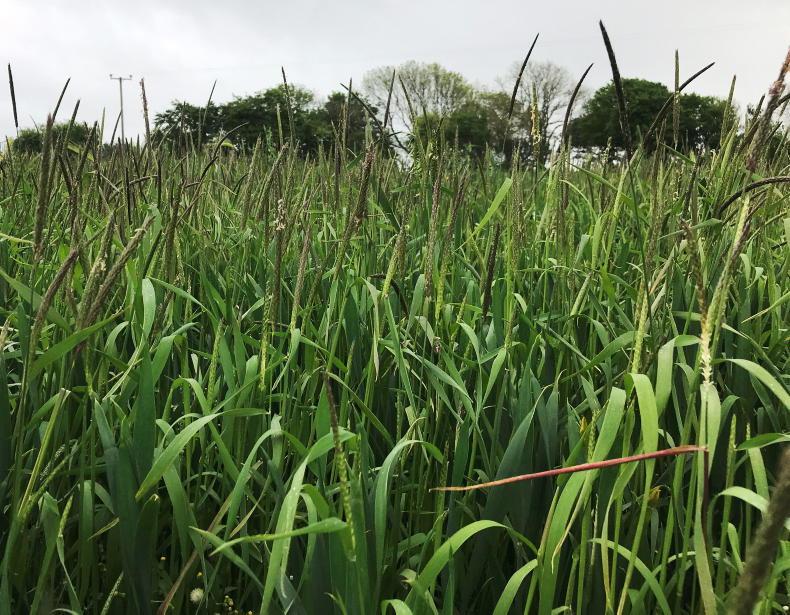Blackgrass is now a noxious weed. Minister for Agriculture Martin Heydon has signed a new Statutory Instrument on Noxious Weeds, effective from the 14 May 2025.
The new development now makes blackgrass a designated noxious weed for the first time.
A statement from the Department said: "This Statutory Instrument also consolidates all secondary legislation on noxious weeds, codifies the existing species of noxious weeds with their botanical names and in addition, the legislation limits controls to certain species of thistle and dock."
The Noxious weeds act makes it an offence for owners and occupiers of land not to prevent the spread of specified weeds.
The legislation now includes the following weeds:
Blackgrass (Alopecurus myosuroides Huds.)Broad-Leaved Dock (Rumex obtusifolius L.)Common Ragwort (Jacobaea vulgaris Gaertn.)Creeping Thistle (Cirsium arvense (L.) Scop.)Curled Dock (Rumex crispus L.)Spear Thistle (Cirsium vulgare (Savi) Ten.)Spring Wild Oat (Avena fatua L.)Winter Wild Oat (Avena sterilis L.)The development comes following the suggestion that blackgrass should be a noxious weed by the Irish Farmers Journal in June 2022.
The Department launched a Public Consultation on 1 November 2024, setting out proposals to amend the existing secondary legislation on noxious weeds.
Minister Heydon said: “Blackgrass poses a significant weed control challenge in this country. Adding Blackgrass to the list of noxious weeds now requires landowners to take responsibility for the control of this weed on their land. It is also timely to remind farmers, Local Authorities and others that it is an offence for owners and occupiers of land not to prevent the spread of noxious weeds”.
The Department stated: "The Department issues ‘Notices to Destroy’ letters in all instances where it becomes aware of the presence of noxious weeds, either from inspections or as a result of reports made by the public. In addition, farmers are obliged under conditionality requirements to take appropriate measures to prevent the spread of noxious weeds under Good Agricultural and Environmental Condition (GAEC) number 8. Failure to do so may result in the application of a reduction of their area-based payments."
Blackgrass is now a noxious weed. Minister for Agriculture Martin Heydon has signed a new Statutory Instrument on Noxious Weeds, effective from the 14 May 2025.
The new development now makes blackgrass a designated noxious weed for the first time.
A statement from the Department said: "This Statutory Instrument also consolidates all secondary legislation on noxious weeds, codifies the existing species of noxious weeds with their botanical names and in addition, the legislation limits controls to certain species of thistle and dock."
The Noxious weeds act makes it an offence for owners and occupiers of land not to prevent the spread of specified weeds.
The legislation now includes the following weeds:
Blackgrass (Alopecurus myosuroides Huds.)Broad-Leaved Dock (Rumex obtusifolius L.)Common Ragwort (Jacobaea vulgaris Gaertn.)Creeping Thistle (Cirsium arvense (L.) Scop.)Curled Dock (Rumex crispus L.)Spear Thistle (Cirsium vulgare (Savi) Ten.)Spring Wild Oat (Avena fatua L.)Winter Wild Oat (Avena sterilis L.)The development comes following the suggestion that blackgrass should be a noxious weed by the Irish Farmers Journal in June 2022.
The Department launched a Public Consultation on 1 November 2024, setting out proposals to amend the existing secondary legislation on noxious weeds.
Minister Heydon said: “Blackgrass poses a significant weed control challenge in this country. Adding Blackgrass to the list of noxious weeds now requires landowners to take responsibility for the control of this weed on their land. It is also timely to remind farmers, Local Authorities and others that it is an offence for owners and occupiers of land not to prevent the spread of noxious weeds”.
The Department stated: "The Department issues ‘Notices to Destroy’ letters in all instances where it becomes aware of the presence of noxious weeds, either from inspections or as a result of reports made by the public. In addition, farmers are obliged under conditionality requirements to take appropriate measures to prevent the spread of noxious weeds under Good Agricultural and Environmental Condition (GAEC) number 8. Failure to do so may result in the application of a reduction of their area-based payments."










SHARING OPTIONS